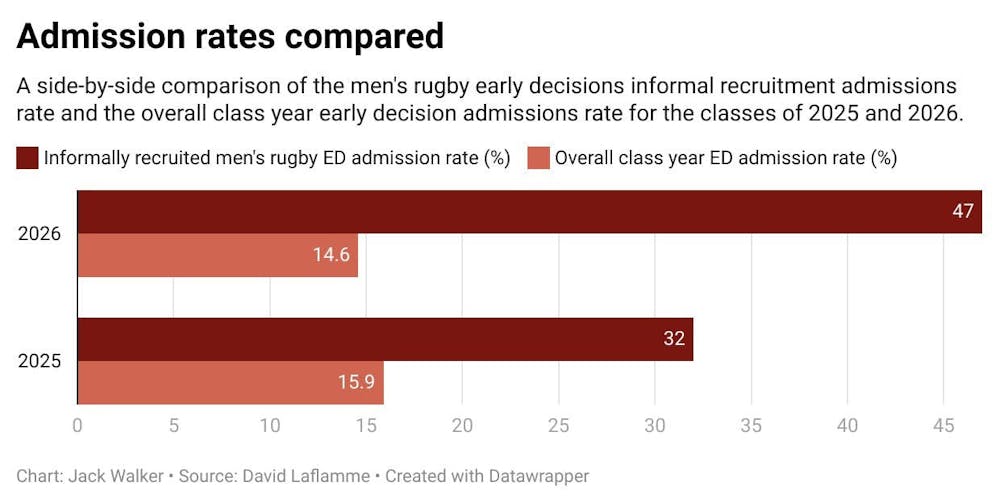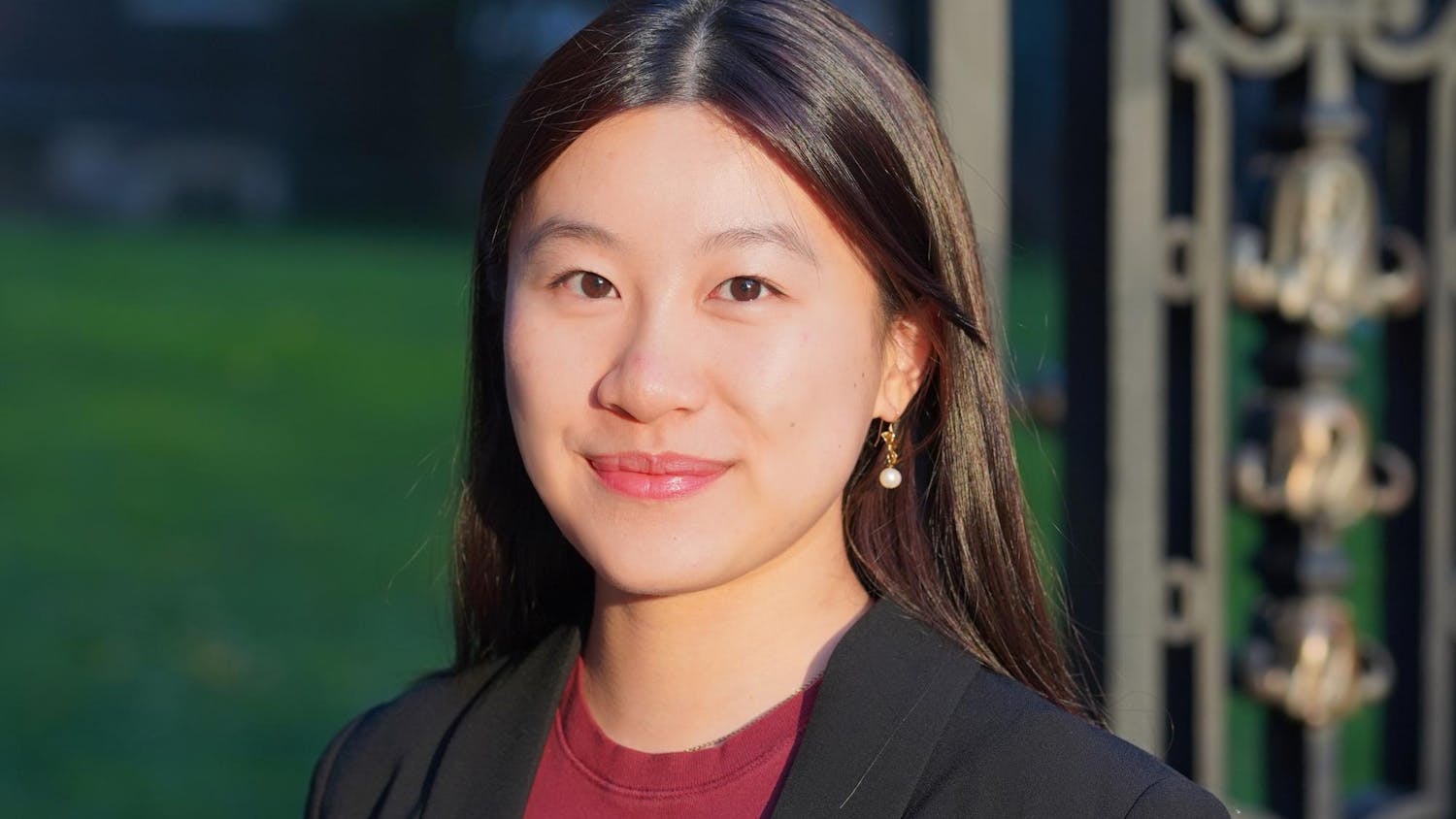After volunteering with the team since 1997, David Laflamme became the University’s first paid, full-time men’s rugby coach in 2015. When he started full-time coaching and began contemplating ways to grow the program, Laflamme said he knew that “the biggest thing” he had to do “was get rugby players to Brown,” so he began a global recruitment push.
Club sports at Brown are divided into three main tiers “based on level of competition and aspiration,” according to Jake Silverman, deputy athletics director for administration. Tier C teams are an “extension of fitness” for recreational purposes, Silverman said. Tier B teams are more competitive and travel to play against other colleges. Tier A teams, like men’s rugby, are nationally competitive programs with full-time coaches such as Laflamme, according to Silverman.
Unlike varsity athletics, club sports do not receive formal recruiting slots or funding from the University. But some Tier A club sports, including fencing, squash and rugby, have relationships with the Office of Admission that allow informal recruiting to take place, Silverman said.
“There might be a squash player interested in applying to Brown but also interested in competing in squash,” Silverman said. “We would share that information for admissions to consider. It’s a little different than what a varsity program might experience.”
Those relationships can lead to a higher rate of admission for some athletes that are not on varsity teams — even if the process isn’t as formal as the varsity process, according to Silverman, as well as club athletes and coaches who spoke with The Herald.
The Herald reached out to coaches and players from every Tier A club team, some of which were demoted from varsity to club status in 2020 as part of the Excellence in Brown Athletics Initiative. The methods of recruiting varied significantly from team to team, ranging from letters of recommendation to the Office of Admission from coaches on behalf of prospective athletes to recruitment by current team members at the semesterly activities fair.
Current Tier A club teams: Men’s rugby, men’s ultimate frisbee, men’s skiing
Laflamme said that he completes a write-up for each prospective athlete he is interested in adding to the team. Admissions considers this write-up as one part of the holistic admissions process; there’s no “free pass” into the school, he added.
“We see a strong benefit in providing that information to our admissions partners, but there’s not the same level of sophistication and organization” as in varsity recruitment, Silverman said. “We’re really just providing information, and hopefully it’s a benefit to Brown admissions in developing each class year that enters Brown.”
In class of 2026 early decision admissions, 8 out of 17 informally recruited rugby applicants were accepted, Laflamme said. This is a 47% acceptance rate, significantly higher than the overall class of 2026 early decision acceptance rate, which was 14.6%. Laflamme’s average acceptance rate between early and regular decision from year to year is around 23%, he said. But “it’s tough to predict because I don’t have recruitment slots,” Laflamme said.
In class of 2025 early decision admissions, Laflamme said that 32% of the athletes he scouted were accepted. The University’s class of 2025 early decision acceptance rate was 15.9%, The Herald previously reported.
In an email to The Herald, Dean of Admission Logan Powell wrote that the University only reports overall admission rates for early and regular decision, and that he could not comment on the admissions rate referenced by Laflamme.
Powell noted that the Office of Admission works closely with Laflamme to “identify scholar athletes who meet our very high standards of admission.”
“Recruited club sport athletes go through the exact same admissions process as all students and are expected to have the same superlative academic credentials and demonstrated ability to contribute in positive ways to the Brown community,” Powell added.
Because the University has such a high volume of applicants, informal recruiting helps admissions officers shape incoming classes, Silverman added. “I think what our coaches generally provide is insight into the application pool that might otherwise not be there.”
Men’s rugby is divided into a competitive group and a developmental group, which require varying levels of skill and time commitment. Laflamme said that it’s important that his athletes put their academics first and can switch between groups depending on other commitments. Academic and athletics flexibility is made possible by rugby’s status as a club rather than varsity sport, he added.
When you’re on the rugby team, Laflamme said, “you really get the best of both worlds.”
Because there is no formal recruiting, “you still have to have the scores and essays for yourself, which I think really yields to a cool club culture,” Daniel Archer ’23, men's rugby captain, said. “Everyone’s really into their academics. It’s really nice to be around a bunch of guys who are really passionate about studying and about playing rugby.”
Other club athletes who spoke to The Herald detailed different recruiting processes for their teams.
Men’s ultimate frisbee, which has never been a varsity sport, engages in informal recruitment processes for its higher-level A team. But the team’s recruitment techniques do not involve the admissions office, Jacques Nissen ’23.5, frisbee team captain, said.
Unlike with other club sports that participate in informal recruiting, the men’s frisbee coach — a volunteer — is not involved in the recruitment process, Nissen said. Instead, interested students can reach out to a team captain or students they know on the team such as old high school teammates or rivals and arrange for a visit.
“Most of the recruiting is done through existing connections,” Nissen said.
Out of 24 people on the team, Nissen says about 75% played frisbee in high school and four to five visited the team before enrolling at Brown.
Nissen personally spent time with the frisbee team before deciding to go to Brown. During his junior year of high school, Nissen, who is from Washington, D.C., messaged one of the then-captains of the men’s frisbee team. Later that year, Nissen visited Brown to join the team for a practice and evaluate the team culture in order to make a decision about whether he’d be interested in joining the team if he were accepted at Brown.
Although Nissen believes in the importance of recruitment to the team, he also reflected on what people without an ultimate frisbee background bring to the team.
“I do think it’s important,” Nissen said of the team’s recruitment processes. “But one thing that makes ultimate great is it’s really easy to pick up the sport and learn across four years of college. Each year we get three or four people who come from other high school sports, and by the time they graduate senior year, they’re a complete player.”
“If everyone on the team ends up being recruited, it removes that aspect of the sport that we really enjoy,” Nissen said.
While the women’s skiing team was demoted to club status in 2020, men’s skiing has always been a club team. Neither team has a coach. According to Maguire Anuszewski ’23, men’s skiing captain, there is no recruitment process prior to prospective skiers arriving on campus.
This year, Anuszewski said the team “advertised at the club fair, and then from there, athletes would sign up.”
Demoted Tier A club teams: Squash, golf, men’s fencing, women’s skiing
Brown demoted 11 teams from varsity to club status in 2020 as part of the Excellence in Brown Athletics Initiative. Because of the change in status, one such team, squash, receives no funding from the University, including for new men’s squash coach Arthur Gaskin’s salary. His salary is funded by donations from alums and parents, Gaskin said. He said he still recruits athletes to the program, but the process has changed dramatically.
Like Laflamme, Gaskin has a “relationship” with the admissions office, but as a club sport, the squash program no longer has formal recruiting spots.
Because he was hired in November 2021, his first opportunity to recruit was for the 2022 regular decision cycle, which will admit applicants to the class of 2026. He has submitted the names of two athletes he hopes will be accepted to Brown. He said he won’t know if they are accepted until April when regular decisions come out.
“It’s going to be tough,” Gaskin said of maintaining high levels of talent on the team without official recruiting spots. “We’re going to have a smaller pool of people from which to draw.”
Men’s and women’s golf also transitioned from varsity to club status as part of the Excellence in Brown Athletics Initiative. Men’s and women’s golf Head Coach Michael Hughes said he has not yet engaged in informal recruiting processes.
Hughes noted that after the team’s transition, all eight male varsity players opted to return and play for the club team. The golf teams each typically bring seven individuals to competitions.
“I was fortunate enough to have all the varsity players on the men’s side continue to want to compete,” Hughes said. “I had no need to recruit for this or next year.”
Because only three student-athletes decided to continue playing on the transitioned women’s golf team, Hughes said that he “will be focused on spreading the word on campus to find interested women to join our team so we may field a complete women's team next fall.”
Nathan Andrews ’24, a member of the men’s fencing team, was recruited before the team transitioned from varsity to club status and underwent an informal process — similar to what a prospective fencer for the men’s team might go through today, according to Andrews. He was informally recruited because the formal recruitment spots were filled by other fencers.
“I emailed the coach and then we talked. I sent him my SAT scores and some of my results,” Andrews said, and the coach “talked to the admissions office.”
Fencing Head Coach Alex Ripa did not respond to requests for comment from The Herald.
Charles Alaimo ’25 is also on the men’s fencing team. Though he was a competitive fencer in high school, he was not planning on fencing in college, and thus, only joined the team after he saw the men’s fencing booth at the activities fair.
“I ended up walking on … because (men’s fencing) is a club team now,” Alaimo said.
According to Alaimo, the men’s fencing team shares the same coach and funding as the women’s team, which is still varsity.
According to women’s skiing team member Athena von Bothmer ’25, women’s skiing was a D3 team until its demotion to club status.
The team size was kept small this year due to the varsity-to-club transition, von Bothmer said. The team still races D3 schools such as Babson, MIT and Amherst. According to von Bothmer, some of the members of the team were recruited when the team was still varsity.
When von Bothmer arrived on campus she exchanged emails with the team's then captain. “I talked to the captain before trying out to see how much of a time commitment it would be and what level the team was,” von Bothmer said. “After that, I sent in some videos of me skiing and racing and shared any experience. That turned out to be enough for me to be on the team.”





